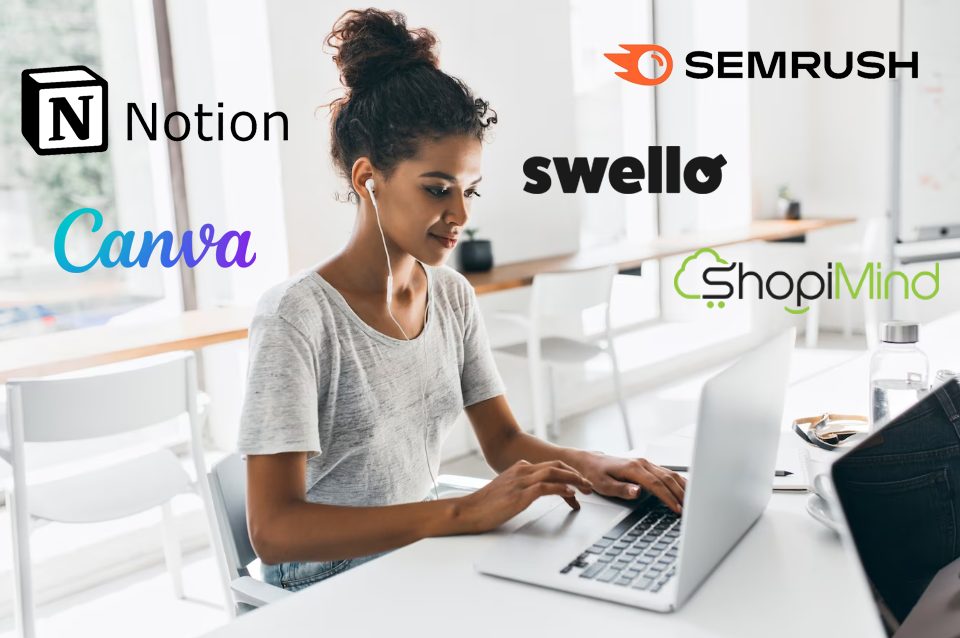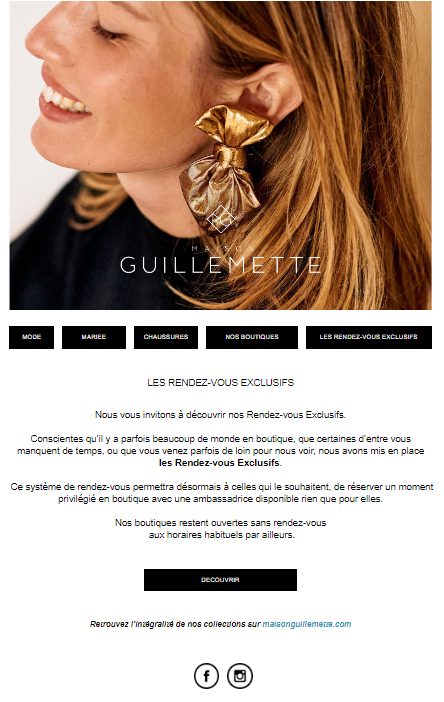Email marketing is a powerful tool for e-merchants. Among the various forms of email, the newsletter stands out for its many advantages.
In this article, we will explore the differences between newsletters and traditional email marketing, the advantages of setting up a newsletter, strategies to adopt before getting started, advice on content and authenticity, and we will finish with a list of 15 newsletter ideas applicable to all e-merchants.
Differences between Newsletters and Email Marketing
Before diving into the details, it is crucial to understand the distinction between a newsletter and email marketing:
Email Marketing
These are one-off emails sent with the aim of triggering an action (sale, feedback, download, etc.). Marketing emails are generally a series of emails sent automatically following an action, mainly carried out on your e-commerce site.
- Welcome sequence
- Abandoned basket sequence
- Re-engagement sequence
- Post-purchase sequence.

Newsletter
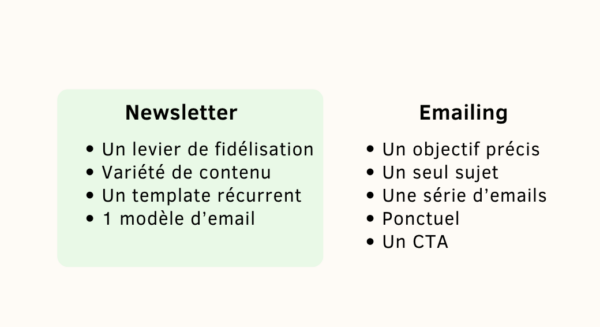 A newsletter is a regularly sent email that aims to inform, educate and engage your audience. A newsletter can contain blog articles, company news, advice, etc.
A newsletter is a regularly sent email that aims to inform, educate and engage your audience. A newsletter can contain blog articles, company news, advice, etc.
The advantages of a newsletter
Setting up a newsletter offers many advantages for e-merchants:
1. Continuous Engagement: A regular newsletter allows you to stay in constant contact with your customers, thus strengthening the relationship.
2. Loyalty: By offering valuable content, you can build customer loyalty and increase their brand loyalty.
3. Subtle Promotion: Unlike aggressive promotional emails, a newsletter allows you to promote your products in a softer and more engaging way.
xml-ph-0000@deepl.internal
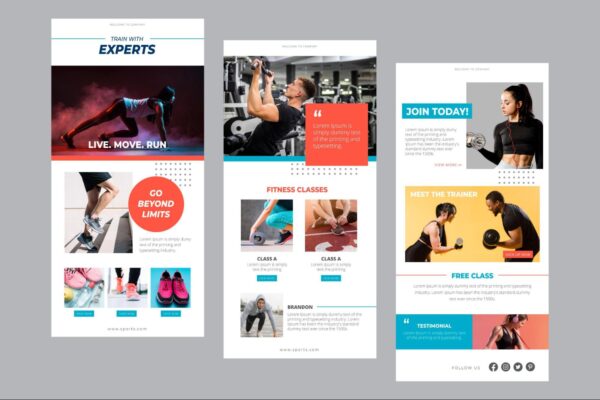 3. Subtle promotion: Unlike aggressive promotional emails, a newsletter allows you to promote your products in a more gentle and engaging way.
3. Subtle promotion: Unlike aggressive promotional emails, a newsletter allows you to promote your products in a more gentle and engaging way.
5. Brand Image:
A
well-designed newsletter helps improve your brand image and establish your expertise in your field.
T
he newsletter is an appointment. A bit like the one you give to a friend. Before an appointment, you are looking forward to it, you are excited and you have a good time, because the exchanges are interesting.
Strategy before getting started
1) Define your target audience
Who will be your readers? Are you addressing your customers or potential customers? What do they want to read?
- Advice
- Behind the scenes of your e-commerce
- Articles
- Tutorials
- Opinions / user experience
2) Set a regular sending frequency.
Opt for a sending frequency that you can maintain on a regular basis. Don’t commit to a rhythm that you won’t be able to keep, at the risk of losing your subscribers’ interest.
- BtoB: Avoid Monday mornings and Friday afternoons.
- BtoC: Avoid Wednesday afternoons, especially if you are targeting mums.
Carry out A/B tests for three weeks to identify the best time to send.
You can also rely on Marketing Automation & Email platforms, which automatically determine the best day and time to sendyour message.
At ShopiMind, this specific feature, generated by a combination of algorithms, is called Perfect timing.

Set SMART (Specific, Measurable, Attainable, Realistic and Time-bound) goals for your newsletter.
Be honest with yourself about what you can accomplish.
- Build customer loyalty
- Create a relationship
- Attract prospects
- Increase traffic to your website
- Educate your audience
- Encourage engagement on social networks
- Announce events
- Building a community
4) Plan your themes / Subjects
5) Choose a tone & an Editorial Line
The tone and editorial line must be consistent with your overall communication strategy.
Offer content that competitors do not offer or present it in a unique way.
Let’s build a unique and effective emailing strategy that will save you time and money.
Tips for effective content
The subject of the email
The subject of the email is the first thing your subscribers see.
Here are a few tips to make it effective:
Be clear and precise: Clearly indicate the content of the email.
- Be clear and precise: Clearly state the content of the email.
- In relation to the content: Make sure that the subject line accurately reflects the content of the email to avoid disappointment.
- Short and concise: Limit the subject to less than 50 characters so that it is easily readable on all devices.
- Avoid spam words: Avoid terms that could send your email to the spam folder, such as “free” or “urgent”.
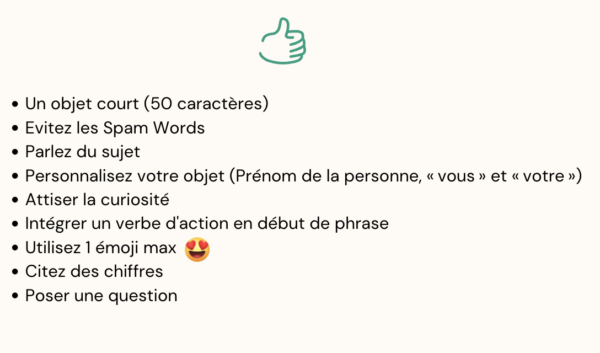
Authentic and personalised copywriting
Authentic and personalised copywriting
Copywriting is a fundamental pillar for capturing and maintaining the attention of your readers.
Here’s how to make your content more appealing:
- Concise and Impactful: Opt for concise and punchy writing, avoiding long digressions.
- Key Structuring: Use titles and subtitles to organise your content clearly and make it easier to read.
- Authentic and Engaging Tone: Adopt an authentic and warm tone, thus creating a natural connection with your subscribers.
Authenticity plays a crucial role in establishing a relationship of trust with your audience. Be transparent about your intentions, share real anecdotes about your company and reveal what goes on behind the scenes.
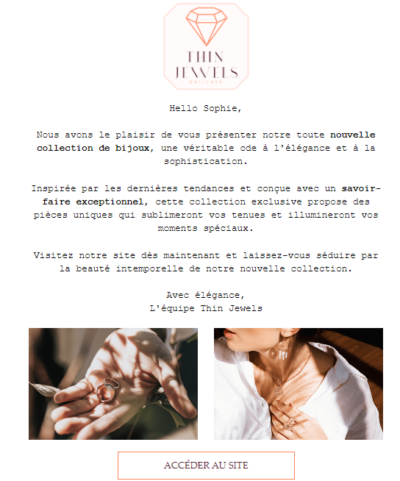 Personalising your emails is another powerful strategy. Personalised messages generate six times more transactions. Use the data you have on your subscribers to personalise the content of your emails, for example by including their first or last name.
Personalising your emails is another powerful strategy. Personalised messages generate six times more transactions. Use the data you have on your subscribers to personalise the content of your emails, for example by including their first or last name.
Won’t I annoy people?
A legitimate concern for many e-merchants is whether they risk “bombarding” their subscribers by sending them too many newsletters.
To avoid falling into the spam trap and maintain your audience’s engagement, here are some best practices to follow:
- Respect the sending frequency: Avoid sending newsletters too frequently, as this could annoy your subscribers. Find a balance between maintaining your brand’s presence and respecting your subscribers’ time and attention.
- Offer quality content with each mailing: Make sure your newsletters provide real added value to your subscribers. Offer interesting information, exclusive promotions or practical advice that generates interest and commitment.
- Encourage interaction: Include clear and appealing calls to action in your newsletter to encourage subscribers to interact with your brand. Invite them to visit your website, take part in a competition or share their opinion on social media.
- Make it easy to unsubscribe: Include a clearly visible and easy-to-find unsubscribe link in every newsletter. Give your subscribers the option to unsubscribe easily if they wish, to respect their choice and their privacy.
- Monitor performance indicators: Track key performance indicators such as open rate, click-through rate and unsubscribe rate to assess the effectiveness of your newsletters. Use this data to adjust your mailing strategy and continuously improve your performance.
15 Newsletter Ideas for E-Retailers
1. Company Creation: Tell the story of how your e-commerce business was created.
2. Team: Introduce the founders and employees.
3. Mission: Explain how your company differs from the competition.
4. Values and Commitments: Highlight your company’s values.
5. Partners and Suppliers: Present your partners and suppliers.
6. Customer Testimonials: Share inspiring stories from satisfied customers.
7. Industry Information: Provide information related to your industry.
8. Tips and Tricks: Offer useful tips related to your products or services.
9. Events and Festivals: Adapt your content to festivals and events.
10. FAQ: Answer your customers’ frequently asked questions.
11. Feedback: Ask your subscribers for feedback.
12. Recommendations: Suggest things to do or products to try (lists of products generated using ShopiMind AI, for example?).
13. Interviews: interview experts or influencers.
14. Inspirational Stories: Share inspiring words from your guests.
15. Exclusive Content: Offer content reserved for your subscribers.
By following this advice and implementing a well-defined strategy, you can create an effective newsletter that engages your customers, strengthens their loyalty and contributes to the growth of your business.
Happy creating!
Let’s build a unique and effective emailing strategy that will save you time and money.
Book your free call: https://calendly.com/exposito-julie/rendez-vous-decouverte-offert-30-minutes
Related Articles
Whether you are an overworked e-merchant or an overburdened E-commerce/Marketing […]
The start of the new school year in September is […]
More often used to promote sales, the newsletter can nevertheless […]

